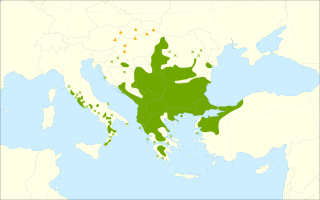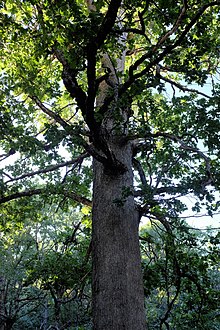
Nepeta is a genus of flowering plants in the family Lamiaceae. The genus name is reportedly in reference to Nepete, an ancient Etruscan city. There are about 250 species.

Quercus robur, the pedunculate oak, is a species of flowering plant in the beech and oak family, Fagaceae. It is a large tree, native to most of Europe and western Asia, and is widely cultivated in other temperate regions. It grows on circumneutral soils in the lowlands and is notable for its value to natural ecosystems, supporting a very wide diversity of herbivorous insects and other pests, predators and pathogens.

Quercus ilex, the evergreen oak, holly oak or holm oak is a large evergreen oak native to the Mediterranean region. It is a member of the Ilex section of the genus, with acorns that mature in a single summer.

Quercus cerris, the Turkey oak or Austrian oak, is an oak native to south-eastern Europe and Asia Minor. It is the type species of Quercus sect. Cerris, a section of the genus characterised by shoot buds surrounded by soft bristles, bristle-tipped leaf lobes, and acorns that usually mature in 18 months.

Quercus petraea, commonly known as the sessile oak, Cornish oak, Irish Oak or durmast oak, is a species of oak tree native to most of Europe and into Anatolia and Iran. The sessile oak is the national tree of Ireland, and an unofficial emblem in Wales and Cornwall.

Quercus frainetto, commonly known as the Hungarian oak or Italian oak, is a species of oak, native to southeastern Europe and Turkey. It is classified in Quercus sect. Quercus.

Quercus tomentella, the island oak, island live oak, or Channel Island oak, is an oak in the section Protobalanus. It is native to six islands: five of the Channel Islands of California and Guadalupe Island, part of Baja California.

Abies pinsapo, the Spanish fir, is a species of tree in the family Pinaceae, native to southern Spain and northern Morocco. Related to other species of Mediterranean firs, it appears at altitudes of 900–1,800 metres (3,000–5,900 ft) in the Sierra de Grazalema in the Province of Cádiz and the Sierra de las Nieves and Sierra Bermeja, both near Ronda in the province of Málaga. In Morocco, it is limited to the Rif Mountains at altitudes of 1,400–2,100 metres (4,600–6,900 ft) on Jebel Tissouka and Jebel Tazaot.

Anthemis is a genus of aromatic flowering plants in the family Asteraceae, closely related to Chamaemelum, and like that genus, known by the common name chamomile; some species are also called dog-fennel or mayweed. Anthemis are native to the Mediterranean region and southwest Asia east to Iran. A number of species have also become naturalized in the United Kingdom and other parts of the world.

Isatis is a genus of flowering plants in the family Brassicaceae, native to the Mediterranean region east to central Asia. Its genus name, Isatis, derives from the ancient Greek word for the plant, ἰσάτις. The genus includes woad. Due to their extremely variable morphology, the Asian species in particular are difficult to determine; the only reliable diagnostic feature is the ripe fruit. They are (usually) biennial or perennial herbaceous plants, often bluish and hairless or downy hairy with the upright stem branched.

Quercus phellos, the willow oak, is a North American species of a deciduous tree in the red oak group of oaks. It is native to the south-central and eastern United States.
Umbilicus chloranthus is a species of flowering plant in the Crassulaceae family. It is referred to by the common names green Venus' navel and ombelico di Venere verdastro. It is native to Albania, the East Aegean Islands, Greece, Turkey, and Yugoslavia.

Quercus rugosa, commonly known as the netleaf oak, is a broad-leaved tree in the beech and oak family Fagaceae. It is native to southern North America.

Quercus ithaburensis, the Mount Tabor oak, is a tree in the beech family Fagaceae. It is found from southeastern Italy to the Palestine region. It is the national tree of Jordan. Two subspecies are accepted, Quercus ithaburensis subsp. ithaburensis and Quercus ithaburensis subsp. macrolepis. Together with Quercus brantii, it forms a clade of distinct, closely related species within the oak section Cerris.

Quercus lanata, the woolly-leaved oak, is a species of Quercus native to southern and southeastern Asia, including India, Bhutan, Nepal, Indochina, and southwestern China. It is a large evergreen tree up to 30 metres tall. The leaves are thick and leathery, green on top but covered in thick wool on the underside. It is classified in subgenus Cerris, section Ilex.

Quercus geminata, commonly called sand live oak, is an evergreen oak tree native to the coastal regions of the subtropical southeastern United States, along the Atlantic Coast from southern Florida northward to southeastern Virginia and along the Gulf Coast westward to southern Mississippi, on seacoast dunes and on white sands in evergreen oak scrubs.

Quercus pyrenaica, commonly known as Pyrenean oak, is a tree native to southwestern Europe and northwestern North Africa. Despite its common name, it is rarely found in the Pyrenees Mountains and is more abundant in northern Portugal and north and northwestern Spain.
Gagea amblyopetala is a Eurasian species of plants in the lily family, Liliaceae. It is native to the Aegean Islands, Albania, Crete, Crimea, Greece, Italy, Sicily, Turkey, Yugoslavia. It is a bulb-forming perennial with yellow flowers.
Quercus ungeri is a species of flowering plant in the family Fagaceae, native to north-west Iran. It was first described by Theodor Kotschy in 1858. It is placed in Quercus section Cerris.


















